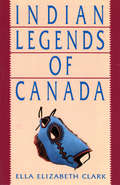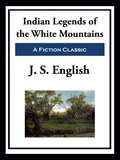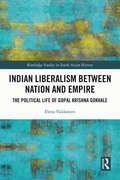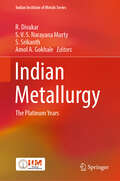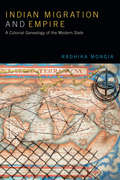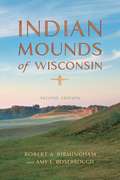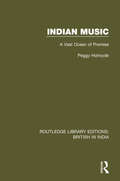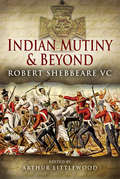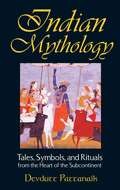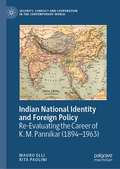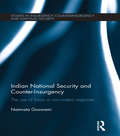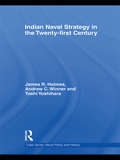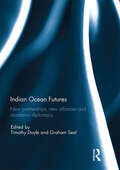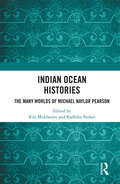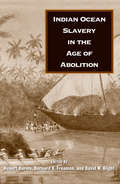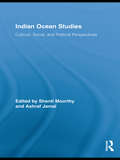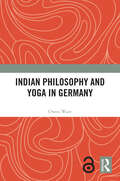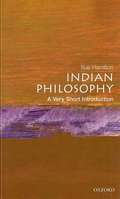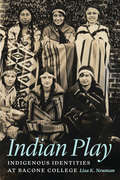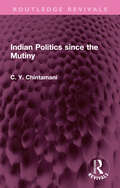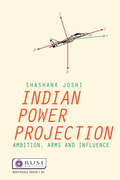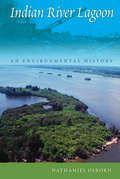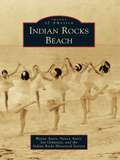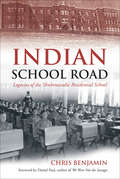- Table View
- List View
Indian Legends of Canada
by Ella Elizabeth ClarkThe role of storyteller was always a very special one among Native Americans, combining the functions of philosopher, historian, and entertainer. Winter was the time for the stories around the fire, when the hunt was over and people longed to be “lifted to the fairyland of pure imagination,” as an early twentieth-century Native American has said. This book contains the magic created around the Indian fireside, for readers of all ages. It includes myths of creation, culture myths, nature myths, and beast fables, as well as the legends, personal narratives and historical traditions of thirty North American Indian tribes.
Indian Legends of the White Mountains
by J. S. EnglishIndian Legends of the White Mountains is a collection of Folklore from in and around the &“Crystal Hills&” of New Hampshire gathered from tales of old settlers and records in historical societies and town libraries. Included are: Chocorua Mount Washington The Giant&’s Grave Nancy&’s Brook The Red Carbuncle Ellis River Ellis River and Jackson, N. H. Moosilauke and the Pemigewassets Cold Streams Rogers&’ Rangers and the Sack of St. Francis Legend of Eagle Mountain Captain Lovewell&’s Fight with Paugus
Indian Liberalism between Nation and Empire: The Political Life of Gopal Krishna Gokhale (Routledge Studies in South Asian History)
by Elena ValdameriThis book analyses the political thought and practice of Gopal Krishna Gokhale (1866–1915), preeminent liberal leader of the Indian National Congress who was able to give a ‘global voice’ to the Indian cause. Using liberalism, nationalism, cosmopolitanism and citizenship as the four main thematic foci, the book illuminates the entanglement of Gopal Krishna Gokhale’s political ideas and action with broader social, political and cultural developments within and beyond the Indian national frame. The author analyses Gokhale’s thinking on a range of issues such as nationhood, education, citizenship, modernity, caste, social service, cosmopolitanism and the ‘women’s question,’ which historians have either overlooked or inserted in a rigid nation-bounded historical narrative. The book provides new enriching dimensions to the understanding of Gokhale, whose ideas remain relevant in contemporary India. A new biography of Gokhale that brings into consideration current questions within historiographical debates, this book is a timely and welcome addition to the fields of intellectual history, the history of political thought, Colonial history and Indian and South Asian history.
Indian Metallurgy: The Platinum Years (Indian Institute of Metals Series)
by Amol A. Gokhale R. Divakar S. V. S. Narayana Murty S. SrikanthThe book marks the Platinum Jubilee of the Indian Institute of Metals, closely matching independent India's age. It is envisaged as a compilation of technical articles tracing the birth and growth trajectory of metallurgical science, engineering and technology in the nation, attempting a degree of prognostication covering the next quarter of a century. It contains the essence of the metallurgical research and development and industrial progress India has witnessed in the last 75 years. This book comprises technical articles written by industry leaders and eminent technocrats. It includes overviews by distinguished researchers who have strived to build foundations of new metallurgical research and engineering fields. It includes learned writings of persons associated with premier institutions heavily dependent on metallurgy and materials. They have made seminal contributions by nurturing the growth of metallurgical research and industrial production or have made first-hand contributions to building the great organisations we have today. Coinciding with the Platinum Jubilee year of the Indian Institute of Metals, this book brings out the enormous efforts of these individuals representing their organisations to share insights that led to their success as an entity. Similarly, several professionals who significantly contributed to the understanding of metallurgical engineering, have held important positions and steered the national strategic programmes or academically nurtured students in their illustrious careers also share their journey in this book. This book chronicles the significant advances made in the field of metallurgical science, engineering and technology in India, presenting the historical perspective and prospects in the format of a technical volume.
Indian Migration and Empire: A Colonial Genealogy of the Modern State
by Radhika MongiaHow did states come to monopolize control over migration? What do the processes that produced this monopoly tell us about the modern state? In Indian Migration and Empire Radhika Mongia provocatively argues that the formation of colonial migration regulations was dependent upon, accompanied by, and generative of profound changes in normative conceptions of the modern state. Focused on state regulation of colonial Indian migration between 1834 and 1917, Mongia illuminates the genesis of central techniques of migration control. She shows how important elements of current migration regimes, including the notion of state sovereignty as embodying the authority to control migration, the distinction between free and forced migration, the emergence of passports, the formation of migration bureaucracies, and the incorporation of kinship relations into migration logics, are the product of complex debates that attended colonial migrations. By charting how state control of migration was critical to the transformation of a world dominated by empire-states into a world dominated by nation-states, Mongia challenges positions that posit a stark distinction between the colonial state and the modern state to trace aspects of their entanglements.
Indian Mounds of Wisconsin
by Robert A. Birmingham Amy L. RosebroughMore mounds were built by ancient Native Americans in Wisconsin than in any other region of North America—between 15,000 and 20,000, at least 4,000 of which remain today. Most impressive are the effigy mounds, huge earthworks sculpted in the shapes of thunderbirds, water panthers, and other forms, not found anywhere else in the world in such concentrations. This second edition is updated throughout, incorporating exciting new research and satellite imagery. Written for general readers, it offers a comprehensive overview of these intriguing earthworks. Citing evidence from past excavations, ethnography, the traditions of present-day Native Americans in the Midwest, ground-penetrating radar and LIDAR imaging, and recent findings of other archaeologists, Robert A. Birmingham and Amy L. Rosebrough argue that effigy mound groups are cosmological maps that model belief systems and relations with the spirit world. The authors advocate for their preservation and emphasize that Native peoples consider the mounds sacred places. This edition also includes an expanded list of public parks and preserves where mounds can be respectfully viewed, such as the Kingsley Bend mounds near Wisconsin Dells, an outstanding effigy group maintained by the Ho-Chunk Nation, and the Man Mound Park near Baraboo, the only extant human-shaped effigy mound in the world.
Indian Music: A Vast Ocean of Promise (Routledge Library Editions: British in India #15)
by Peggy HolroydeIn this book, first published in 1972, Indian music is given the comprehensive treatment it so richly deserves. The author brings a wealth of association with the country and its music into focus with a general introduction to the cultural and spiritual environment, and to the techniques, instruments and methods of the Indian musician.
Indian Mutiny and Beyond: Robert Shebbeare VC
by Arthur Littlewood"Robert Shebbeare went out as a cadet to India at the age of seventeen and after a spell of ordinary regimental duties, he was caught up in the extraordinary and bloody events of the Indian Mutiny.With fellow officers he managed to escape to Delhi, where he was attached to the Guides, and he took part in most of the action during the long hot summer of 1857. He was wounded six times and was awarded the Victoria Cross for his gallantry during the storming of the city on September 14th. He raised a new regiment, the 15th Punjab, which volunteered for service in China and took part in the advance on Peking in 1860.Tragically, he died en route for England, his family, who had not seen him since he had left 16 years earlier, were all at the quayside to welcome him, unaware that he had been buried at sea.His story is told in his own words from the recently discovered letters which he sent home to his family between 1844–1860. The Editor has provided a commentary that puts the letters into context for the general reader and military historians. "
Indian Mythology: Tales, Symbols, and Rituals from the Heart of the Subcontinent
by Devdutt PattanaikAn exploration of 99 classic myths of India from an entirely non-Western paradigm that provides a fresh understanding of the Hindu spiritual landscape• Compares and contrasts Indian mythology with the stories of the Bible, ancient Egypt, Greece, Scandinavia, and Mesopotamia• Looks at the evolution of Indian narratives and their interpretations over the millennia• Demonstrates how the mythology, rituals, and art of ancient India are still vibrant today and inform the contemporary generationFrom the blood-letting Kali to the mysterious Ganesha, the Hindu spiritual landscape is populated by characters that find no parallel in the Western spiritual world. Indian Mythology explores the rich tapestry of these characters within 99 classic myths, showing that the mythological world of India can be best understood when we move away from a Western, monotheistic mindset and into the polytheistic world of Hindu traditions.Featuring 48 artistic renderings of important mythological figures from across India, the author unlocks the mysteries of the narratives, rituals, and artwork of ancient India to reveal the tension between world-affirming and world-rejecting ideas, between conformism and contradiction, between Shiva and Vishnu, Krishna and Rama, Gauri and Kali. This groundbreaking book opens the door to the unknown and exotic, providing a glimpse into the rich mythic tradition that has empowered millions of human beings for centuries.
Indian National Identity and Foreign Policy: Re-Evaluating the Career of K. M. Pannikar (1894–1963) (Security, Conflict and Cooperation in the Contemporary World)
by Mauro Elli Rita PaoliniShedding light on the role of India within twentieth-century international relations, this book explores the life and career of Kavalam Madhava (K. M.) Panikkar (1894–1963), an Indian historian, statesman and diplomat. Having been involved in Indian intellectual and political life throughout the transition from the British Empire to the Nehruvian era, Panikkar was an important figure in the evolution of the modern Indian state. Based on over four years of extensive research both in India and Europe, and the analysis of public writings and unpublished archival documents, this book examines Panikkar’s role in the Indian national movement, the governance of several Princely states, and India’s foreign policy, notably with China. Not only do the authors critically re-evaluate Panikkar’s intellectual and political thoughts, but also his influence on the broader issue of India’s path towards independence. Offering a valuable contribution to modern Indian diplomatic history and wider international relations, this comprehensive book emphasises Panikkar’s importance in shaping the modern idea of India and crucial elements of Indian foreign policy.
Indian National Movement (1857-1920) First Semester FYBA New NEP Syllabus - SPPU
by Dr Vivek Joshi Ms Rupali KulkarniThe book Indian National Movement (1857–1920) by Dr. Vivek Joshi and Ms. Rupali Kulkarni provides a comprehensive analysis of India's struggle for independence during this pivotal period. It explores the causes, events, and consequences of the Revolt of 1857, often referred to as the First War of Indian Independence, alongside socio-religious reform movements that sought to modernize Indian society. Key topics include the emergence of nationalism, the establishment of the Indian National Congress, and the ideological evolution from moderate to extremist approaches. With detailed accounts of leaders, events, and the sociopolitical impact of this era, the book serves as an essential resource for understanding the roots of India's freedom movement and its early challenges.
Indian National Security and Counter-Insurgency: The use of force vs non-violent response (Studies in Insurgency, Counterinsurgency and National Security)
by Namrata GoswamiThis book, based on extensive field research, examines the Indian state’s response to the multiple insurgencies that have occurred since independence in 1947. In reacting to these various insurgencies, the Indian state has employed a combined approach of force, dialogue, accommodation of ethnic and minority aspirations and, overtime, the state has established a tradition of negotiation with armed ethnic groups in order to bolster its legitimacy based on an accommodative posture. While these efforts have succeeded in resolving the Mizo insurgency, it has only incited levels of violence with regard to others. Within this backdrop of ongoing Indian counter-insurgency, this study provides a set of conditions responsible for the groundswell of insurgencies in India, and some recommendations to better formulate India’s national security policy with regard to its counter-insurgency responses. The study focuses on the national institutions responsible for formulating India’s national security policy dealing with counter-insurgency – such as the Prime Minister’s Office, the Cabinet Committee on Security, the National Security Council, the Ministry of Home Affairs and the Indian military apparatus. Furthermore, it studies how national interests and values influence the formulation of this policy; and the overall success and/or failure of the policy to deal with armed insurgent movements. Notably, the study traces the ideational influence of Kautilya and Gandhi in India’s overall response to insurgencies. Multiple cases of armed ethnic insurgencies in Assam, Manipur, Mizoram, and Nagaland in the Northeast of India and the ideologically oriented Maoist or Naxalite insurgency affecting the heartland of India are analysed in-depth to evaluate the Indian counter-insurgency experience. This book will be of much interest to students of counter-insurgency, Asian politics, ethnic conflict, and security studies in general.
Indian Naval Strategy in the Twenty-first Century (Cass Series: Naval Policy and History)
by James R. Holmes Toshi Yoshihara Andrew C. WinnerThis is the first academic study of India's emerging maritime strategy, and offers a systematic analysis of the interplay between Western military thought and Indian maritime traditions. By a quirk of historical fate, Europe embarked on its Age of Discovery just as the main Asian powers were renouncing the sea, ushering in centuries of Western dominance. In the 21st century, however, Asian states are once again resuming a naval focus, with both China and India dedicating some of their new-found wealth to building powerful navies and coast guards, and drawing up maritime strategies to govern the use of these forces. The United States, like the British Empire before it, is attempting to manage these rising sea powers while preserving its maritime primacy. This book probes how India looks at the sea, what kind of strategy and seagoing forces New Delhi may craft in the coming years, and how Indian leaders may use these forces. It examines the material dimension, but its major premise is that navies represent a physical expression of a society's history, philosophical traditions, and culture. This book, then, ventures a comprehensive appraisal of Indian maritime strategy. This book will be of interest to students of sea power, strategic studies, Indian politics and Asian Studies in general. James R. Holmes is an Associate Professor of Strategy at the U.S. Naval War College and a former U.S. Navy surface warfare officer. Toshi Yoshihara is an Associate Professor in the Strategy and Policy Department at the Naval War College. Andrew C. Winner is Professor in the Strategic Research Department at the U.S. Naval War College.
Indian Ocean Futures: New Partnerships, New Alliances, and Academic Diplomacy
by Graham Seal Timothy DoyleIndian Ocean studies, which once lagged behind studies of the Atlantic and the Pacific, is an important emerging academic field which has come into its own. In the next fifty years, the Indian Ocean Region will become very significant as a result of enormous demographic changes. What was the Ocean of the South is rapidly becoming the Ocean of the Centre, the Ocean of the Future. Curtin University, Western Australia, has a long and distinguished history of engagement with the Indian Ocean region and with Indian Ocean Studies, and its Australia-Asia-Pacific Institute of Curtin University continues to maintain a focus on the Indian Ocean -past, present and future. This book examines a number of themes emerging from its 2014 Conference entitled "Indian Ocean Futures", which attracted some of the best Indian Ocean region scholars. The conference connected humanities, social sciences and scientific disciplines; this book collects some of the preeminent works focused on geo-strategic, cultural, environmental security and human security themes. The book is also an important contribution to the building of academic diplomacy in the region – that is to say, it contributes to region-building by creating epistemic communities and networks between government, the private sector, and academia throughout the region. Through the pursuit of academic diplomacy, academics are capable of pursuing research goals which enhance governmental, business, and civil society objectives of the day. This book was previously published as a special issue of the Journal of the Indian Ocean Region.
Indian Ocean Histories: The Many Worlds of Michael Naylor Pearson
by Radhika Seshan Rila MukherjeeThis book offers a global history of the Indian Ocean and focuses on a holistic perspective of the worlds of water. It builds on maritime historian Michael Naylor Pearson’s works, his unorthodox approach and strong influence on the study of the Indian Ocean in viewing the oceanic space as replete with human experiences and not as an artefact of empire or as the theatre of European commercial and imperial transits focused only on trade. This interdisciplinary volume presents several ways of writing the history of the Indian Ocean. The chapters explore the changing nature of Indian Ocean history through diverse themes, including state and capital, regional identities, maritime networking, South Asian immigrants, Bay of Bengal linkages, the East India Company, Indian seamen, formal and informal collaboration in imperial networking, scientific transfers, pearling, the issues of colonial copyright, customs, excise and port cities. The volume will be useful to scholars and researchers of global history, modern history, maritime history, medieval history, Indian history, colonial history and world history.
Indian Ocean Slavery in the Age of Abolition
by David W. Blight Robert W. Harms Bernard K. FreamonWhile the British were able to accomplish abolition in the trans-Atlantic world by the end of the nineteenth century, their efforts paradoxically caused a great increase in legal and illegal slave trading in the western Indian Ocean. Bringing together essays from leading authorities in the field of slavery studies, this comprehensive work offers an original and creative study of slavery and abolition in the Indian Ocean world during this period. Among the topics discussed are the relationship between British imperialism and slavery; Islamic law and slavery; and the bureaucracy of slave trading.
Indian Ocean Studies: Cultural, Social, and Political Perspectives (Routledge Indian Ocean Series)
by Shanti Moorthy Ashraf JamalThe Indian Ocean is famously referred to as the "cradle of globalization," as it facilitated cultural and economic exchanges between Africa, the Arab world, the Indian subcontinent, Southeast Asia, and China, for 5000 years prior to European presence in the region. As this ocean's significance has gained increasing attention from scholars in recent years, few have examined the 'human' dimensions in Indian Ocean exchanges. Including the work of historians, geographers, anthropologists and literary analysts, each essay in this volume addresses a specific human factor, such as the fate of the creole in the Bay of Bengal, creolization as a globalized phenomenon, migrancy and diaspora, the lives of seafarers then and now, and the lives of those who inhabit the ocean's littoral. This volume is a necessary addition to the field of Indian Ocean studies.
Indian Philosophy and Yoga in Germany
by Owen WareThis book sheds new light on the fascinating – at times dark and at times hopeful – reception of classical Yoga philosophies in Germany during the nineteenth century. When debates over God, religion, and morality were at a boiling point in Europe, Sanskrit translations of classical Indian thought became available for the first time. Almost overnight India became the centre of a major controversy concerning the origins of western religious and intellectual culture. Working forward from this controversy, this book examines how early translations of works such as the Bhagavad Gītā and the Yoga Sūtras were caught in the crossfire of another debate concerning the rise of pantheism, as a doctrine that identifies God and nature. It shows how these theological concerns shaped the image of Indian thought in the work of Schlegel, Gunderrode, Humboldt, Hegel, Schelling, and others, lasting into the nineteenth century and beyond. Furthermore, this book explores how worries about the perceived nihilism of Yoga were addressed by key voices in the early twentieth century Indian Renaissance – notably Dasgupta, Radhakrishnan, and Bhattacharyya – who defended sophisticated counterreadings of their intellectual heritage during the colonial era. Written for non-specialists, Indian Philosophy and Yoga in Germany will be of interest to students and scholars working on nineteenth-century philosophy, Indian philosophy, comparative philosophy, Hindu studies, intellectual history, and religious history.
Indian Philosophy: A Very Short Introduction
by Sue HamiltonIndia has a long, rich, and diverse tradition of philosophical thought, spanning some two and a half millennia and encompassing several major religious traditions. This Very Short Introduction emphasizes the diversity of Indian thought, and is structured around six schools which have achieved classic status. Sue Hamilton explores how the traditions have attempted to understand the nature of reality in terms of an inner or spiritual quest, and introduces distinctively Indian concepts such as karma and rebirth. She also shows how Indian thinkers have understood issues of reality and knowledge -- issues which are also an important part of the Western philosophical tradition.
Indian Play: Indigenous Identities at Bacone College
by Lisa K. NeumanWhen Indian University—now Bacone College—opened its doors in Indian Territory (now Oklahoma) in 1880, it was a small Baptist institution designed to train young Native Americans to be teachers and Christian missionaries among their own people and to act as agents of cultural assimilation. From 1927 to 1957, however, Bacone College changed course and pursued a new strategy of emphasizing the Indian identities of its students and projecting often-romanticized images of Indianness to the non-Indian public in its fund-raising campaigns. Money was funneled back into the school as administrators hired Native American faculty who in turn created innovative curricular programs in music and the arts that encouraged their students to explore and develop their Native identities. Through their frequent use of humor and inventive wordplay to reference Indianness—&“Indian play&”—students articulated the (often contradictory) implications of being educated Indians in mid-twentieth-century America. In this supportive and creative culture, Bacone became an &“Indian school,&” rather than just another &“school for Indians.&”In examining how and why this transformation occurred, Lisa K. Neuman situates the students&’ Indian play within larger theoretical frameworks of cultural creativity, ideologies of authenticity, and counterhegemonic practices that are central to the fields of Native American and indigenous studies today.
Indian Politics since the Mutiny (Routledge Revivals)
by C. Y. ChintamaniFirst Published in 1940 Indian Politics since the Mutiny presents a comprehensive account of the development of public life and political institutions and of prominent political personalities in colonial India. Delivered as lectures at the Andhra University in 1935, the essays discuss themes like Indian politics before the Congress party, the first twenty years of the Congress party, Partition of Bengal, and the Non-cooperation movement. This book is an important historical document from the colonial period in India and will be of interest to scholars and researchers of Indian history, colonial history, and history in general.
Indian Power Projection: Ambition, Arms and Influence (Whitehall Papers)
by Shashank JoshiIndia is growing into one of Asia’s most important military powers. Its defence budget has more than doubled in the past decade, and it imports more arms than anyone else in the world. But India is still seen as a land power focused on long, disputed and militarised borders with Pakistan and China rather than the global military force it was in the first half of the twentieth century under British rule. Is this changing? India is acquiring increasing numbers of key platforms – aircraft carriers, amphibious ships, refuelling tankers and transport aircraft – that are extending its reach to the Indian Ocean littoral and beyond. But most accounts of this build-up have been impressionistic and partial. Indian Power Projection assesses the strength, reach and purposes of India's maturing capabilities. It offers a systematic assessment of India’s ability to conduct long-range airstrikes from land and sea, transport and convey airborne and amphibious forces, and develop the institutional and material enablers that turn platforms into capabilities. It draws extensively on the lessons of modern expeditionary operations, and considers how India’s growing interests might shape where and how it uses these evolving capabilities in the future. This study finds that Indian power projection is in a nascent stage: limited in number, primarily of use against much-weaker adversaries, and deficient in some key supporting capabilities. India’s defence posture will continue to be shaped by local threats, rather than distant interests. Indian leaders remain uncomfortable with talk of military intervention and expeditionary warfare, associating these with colonial and superpower excess. But as the country’s power, interests and capabilities all grow, it is likely that India will once more find itself using military force beyond its land borders.
Indian River Lagoon: An Environmental History
by Nathaniel OsbornStretching along 156 miles of Florida's East Coast, the Indian River Lagoon contains the St. Lucie estuary, the Mosquito Lagoon, Banana River Lagoon, and the Indian River. It is a delicate ecosystem of shifting barrier islands and varying salinity levels due to its many inlets that open and close onto the ocean. The long, ribbon-like lagoon spans both temperate and subtropical climates, resulting in the most biologically diverse estuarine system in the United States.Nineteen canals and five man-made inlets have dramatically reshaped the region in the past two centuries, intensifying its natural instability and challenging its diversity. Indian River Lagoon traces the winding story of the waterway, showing how humans have altered the area to fit their needs and also how the lagoon has influenced the cultures along its shores. Now stuck in transition between a place of labor and a place of recreation, the lagoon has become a chief focus of public concern. This book provides a much-needed bigger picture as debates continue over how best to restore this natural resource.
Indian Rocks Beach (Images of America)
by Wayne Ayers Nancy Ayers Jan Ockunzzi Indian Rocks Historical SocietyAccording to legend, Indian Rocks got its name when Tocobaga Indians brought their ailing chief from inland Florida to drink from the area's sulfur springs, prized for their medicinal qualities. Their leader miraculously recovered, as the story goes, and the tribe returned each year to the place where large rocks surrounded the healing spring. The natural beauty of the barrier island that became Indian Rocks Beach was what attracted Harvey Hendrick to establish his homestead here in the mid-1890s. Years later, he recalled, "I liked the place, I thought it was the most beautiful place on God's green footstool, and I think so yet." The charm and character of this little seaside community is evident in these historic photographs, from the days when the old swing bridge was the center of activity, to the booming post-World War II era when tourists and residents proclaimed Indian Rocks Beach as their special place.
Indian School Road: Legacies of the Shubenacadie Residential School
by Chris BenjaminThe scandalous history of neglect, abuse, and exploitation at a residential school for children—and the ongoing effects in the decades since it closed.In Indian School Road, journalist Chris Benjamin tackles the controversial and tragic history of Canada’s Shubenacadie Indian Residential School, its predecessors, and its lasting effects, giving voice to multiple perspectives for the first time. Benjamin integrates research, interviews, and testimonies to guide readers through the varied experiences of students, principals, and teachers over the school’s nearly forty years of operation, from 1930 to 1967, and beyond. Exposing the raw wounds of the twenty-first-century Truth and Reconciliation Commission, as well as the struggle for an inclusive Mi’kmaw education system, Indian School Road is a comprehensive and compassionate narrative history of the school that uneducated hundreds of Aboriginal children.
